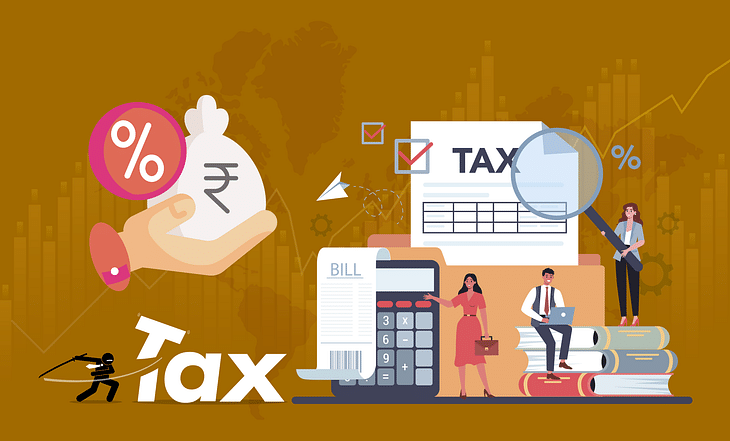Income Tax Structure for Stock Market Investors & Traders

Updated: Feb 3, 2025
Before investing or trading in stock markets, we must clearly understand the risks involved and be aware of the charges or expenses we may incur. Many of you would still be unaware of how income or profits received from the sale of shares are taxed. Let us learn in-depth about the income tax structure that is applicable to stock market investors and traders in India.
Key Terms Related to Income Tax
When you buy and hold shares of a listed company, you become a part-owner of the firm (even though it is a very tiny fraction). These stocks will be referred to as your capital asset. When you hold these shares for more than a year, it is known as a long-term capital asset. If you purchase shares and sell them within 12 months, it is known as a short-term capital asset.
When equity shares are sold within 12 months of purchasing, the seller may obtain a short-term capital gain or incur a short-term capital loss. Similarly, when equity shares listed on a stock exchange are sold after a year of purchasing, the seller may obtain a long-term capital gain or incur a long-term capital loss.
How are Gains from Equity Shares Taxed?
- Long-term capital gain (LTCG) on the sale of equity shares is not taxable up to a limit of Rs 1 lakh. If the long-term capital gain received on selling shares or units of mutual funds exceeds Rs 1 lakh, you will attract a flat tax rate of 12.5%.
- Short-term capital gains (STCG) that you receive from selling shares are taxable at a flat rate of 20%. This is a special tax rate that is levied irrespective of your tax slab. [This may be applicable to swing traders, who buy and hold shares for a few weeks or months]
Taxation on Intraday Traders
According to rules specified by the Income Tax Department, the profit or gain received from intraday trading is considered speculative income. While filing your income tax return, intraday income comes under ‘business income’ that you have received during the year.
Now, imagine that you own a business. At the end of a particular financial year, you have received a total income of Rs 15 lakh from it. You have also received a profit of Rs 5 lakh from intraday trading during the same period. Thus, the total business income for that financial year will be Rs 20 lakh, and income tax will be levied based on the applicable income tax slab. Since intraday profit is considered as a business income, you can claim expenses while filing income tax return. These expenses could be brokerage charges, broadband charges, purchase of personal computers or laptops for trading, etc. Claiming such expenses will help lower the amount on which you need to pay income tax.
Taxation on Derivative Traders
Let us look at how income tax is levied on profits obtained from Futures and Options (F&O) trading. The profits received from F&O trading are also classified as business income (known as non-speculative income). The taxation on derivative traders is similar to that of intraday traders. Thus, you will have to pay tax on income received from such trades based on the applicable tax slab/bracket.
Loss Incurred on Sale of Equity Shares
As investors or traders in the stock market, we are all bound to make losses. However, even if you do not belong to any tax slabs and have incurred losses while investing or trading during a particular financial year, it is always recommended to file your Income Tax Return. This is because such losses can be adjusted and carried forward to upcoming financial years. [Those individuals who receive an annual income of less than Rs 12 lakh are exempt from paying taxes] Let us understand this concept with an example.
Suppose you incurred a long-term capital loss of Rs 2 lakh in the financial year 2019-2020 (FY20). In the next financial year (FY21), you have obtained a long-term capital gain of Rs 5 lakh. Thus, the loss that you incurred in FY20 can be carried forward (or set off) with the profit made in FY21. Thus, you need to only pay tax on Rs 3 lakh during the financial year ended March 31, 2021.
The long-term and short-term capital losses that an investor incurs can be carried forward for up to 8 years. A long-term capital loss can only be set off against long-term capital gains. However, a short-term capital loss can be set off against both LTCG and STCG. Similarly, intraday losses can be carried forward up to 4 years, and losses from F&O trades can be carried forward up to 8 years.
Current Income Tax Slab Rates (Updated)
| Tax Slab - New Regime | Tax Rate | Tax Slab - Old Regime | Tax Rate |
| ₹0 - ₹4 lakh | Nil | ₹0 - ₹3 lakh | Nil |
| ₹4 lakh - ₹8 lakh | 5% | ₹3 lakh - ₹7 lakh | 5% |
| ₹8 lakh - ₹12 lakh | 10% | ₹7 lakh - ₹10 lakh | 10% |
| ₹12 lakh - ₹16 lakh | 15% | ₹10 lakh - ₹12 lakh | 15% |
| ₹16 lakh - ₹20 lakh | 20% | ₹12 lakh - ₹15 lakh | 20% |
| ₹20 lakh - ₹24 lakh | 25% | Above ₹15 lakh | 30% |
| Above ₹24 lakh | 30% | - | - |


Post your comment
No comments to display